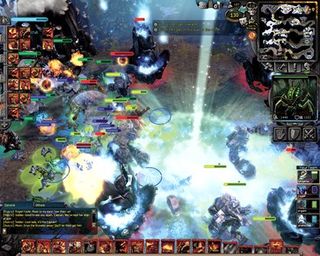Why you can trust 12DOVE
Such defeats bring bitter “They only won because they had the best deck!” feelings. Though there is something called a “tome mode” where each player takes to the field with a deck built from virgin booster packs, there’s no option to play with the vanilla 16-card faction decks, so there is never a truly level playing field. For all its checks and balances, BattleForge would seem to favor the player with the fattest deck.

Not bothered? Only intend to play single-player? Sorry, things aren’t quite that simple. To have any chances of conquering the later campaign challenges (many of which are just harder versions of earlier ones) you’ll need to upgrade your cards. Upgrades - non-tradeable cards dished out as single-player rewards - can only be utilized with the help of multiplayer victory tokens. A lack of success in the arenas means the story’s later stages will be bastard-hard.
But that’s not the most controversial aspect of the design. What’s creating the most furor in forums is the availability of BattleForge points. Many different currencies - gold, honor tokens, battle tokens - slosh about inside the game (most for no apparent reason) but BF points are the only way to buy boosters and cards at auctions. Once you’ve exhausted your initial fund (3,000BF) you must cough up real cash to acquire more. For one dollar you can buy 100BF, so an eight-card booster pack costs around $2.50.

Bargain? I’m genuinely undecided. You could argue that buying a few booster packs a month is no different from paying an MMO subscription. Even if you don’t get cards you need, you can always auction off the cream of your haul. Every pack is guaranteed to include one “rare” card. Perhaps one in 20 will contain a precious “ultra-rare.” That $2.50 is also buying you the nerve-tingly excitement of a treasure-hunt.
The trouble with the MMO argument is that BattleForge, for all its savage splendor and addictiveness, doesn’t provide the player-versus-environment scope and color of a WoW or a Lord of the Rings Online. There isn’t that comforting sense of progress, either. You can spend 30 minutes on a mission, get defeated, and emerge with absolutely nothing.

The game’s best defense against accusations of commercial cynicism is something I hinted at earlier: extra cards are by no means essential. The initial batch will take you far, as long as you upgrade them (meaning plenty of multiplayer play). Rares and ultra-rares will turn heads on the battlefield, but they aren’t silver bullets. A skillful pauper with a modest card selection will still be able to vanquish a talentless spendthrift with a monstrous stack.
As long as you approach BattleForge knowing that it will take all your money and leave you sleeping under cardboard in an underpass given half a chance, it’s hard to envisage disappointment with its deck-building and co-op carnage.

Online activation
PC Gamer scores games on a percentage scale, which is rounded to the closest whole number to determine the GamesRadar score.
PCG Final Verdict: 81% (excellent)
Mar 20, 2009
More info
| Genre | Strategy |
| Description | Ignore the messy plot, Battleforge's awesome co-op and build-your-own army system will have you emptying your wallet for booster packs. |
| Platform | "PC" |
| US censor rating | "Teen" |
| UK censor rating | "12+" |
| Release date | 1 January 1970 (US), 1 January 1970 (UK) |

Lego Fly with Dodo Airlines (77051) review: "A surprisingly good kit which provides maximum brick for buck"

Days after dev layoffs, NetEase confirms Marvel Rivals has surpassed 40 million players, celebrates the company "delivering groundbreaking gaming experiences"

Marvel TV boss isn't ruling out other Defenders re-joining the MCU after Daredevil: Born Again: "It is certainly something that is creatively extremely exciting"
Most Popular




